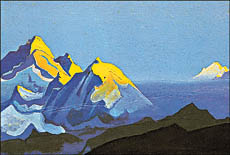

 
 


 
 
|
He captured the soul of Himalayas
By Suman
Sachar
BORN on October 9, 1874, the name
of the Russian painter Nikolai Konstantinovich Roerich is
very dear to India as the great soul spent his last years
with his family in the lap of the Himalayas at Naggar in
Kulu. An artist of international fame and crusader of
"worldwideness", N.K. Roerich created more than
7000 works, that are now dispersed all over the world.
The great original talent of the artist is projected in
the sphere of his use of monumental and applied arts that
border on scenographies and drawings. The archaeologist,
ethnographer, lawyer, geographer, poet, historian,
philosopher, scientist, traveller, fighter for peace,
defender or cultural values of all nations and especially
the Man devoted to common weal in the great painter, have
together left for the world marvellous pieces such as
"The Herald" (1897), "The Overseas
Guests" (1901), "City in Growing" (1902),
"Rostov the Great" (1903), "Three
Joys" (1916), which together project Roerich’s
dear motherland, his Russia, the breeding ground of his
soft all-encompassing sensibility.
 The famous painter was an unrelenting
crusader for peace and oneness of international culture.
About the power of culture, he once wrote: "Where
there is culture ... there is peace. So long as culture
is only a luxury, only a Christmas pudding, it would not
improve life. Culture should come closest to everyday
life, whether it is a hut or a palace." The famous painter was an unrelenting
crusader for peace and oneness of international culture.
About the power of culture, he once wrote: "Where
there is culture ... there is peace. So long as culture
is only a luxury, only a Christmas pudding, it would not
improve life. Culture should come closest to everyday
life, whether it is a hut or a palace."
Roerich strongly
believed in the educative and transforming power of
culture. His strength led him to form the "Roerich
Pact" for the protection of culture and monuments of
all humanity. Albert Einstein, Romain Roland, Bernard
Shaw, Thomas Mann, Hubert Wells, Jawaharlal Nehru,
Rabindranath Tagore and many other personalities
worldwide backed up the "Roerich Pact."
The peace-loving Roerich
had an exclusive place for India in his heart. He loved
it for its beauty, culture, peaceful co-existence and
multi-ethnicity.
Having worked 42 years
in Russia and having travelled 10 years round European
countries and the USA, the great painter spent last 20
years of his life in the East, particularly India. In
1928, Roerich founded the Himalayan Roerich Institute
"Urusvati" which means "Morning star
light." Living in the lap of inspiring Himalayas at
Naggar in Kulu, the artistic soul sketched "The
Himalayas" in a series.
The mountainous
landscapes painted by Roerich have been hailed as
monumental works, heroic and poetic in their
interpretation of nature. The composition of the
artist’s canvas is seen as well-thought out,
balanced and harmonious.The form is invariably precise
and expressive. Mentioning about the truthfulness of the
painter’s landscapes, Indira Gandhi once commented:
"The spirit of the Himalayas and soul of India are
grasped in them." Writing about the great genius,
Jawaharlal Nehru said: "When you look at the
paintings, so many of them of the Himalayas, you seem to
catch the spirit of these great mountains which have
towered over the Indian plain and been our sentinels from
ages. They remind us of spiritual heritage not merely of
the India of the past but of something that is permanent
and eternal about India, that we cannot help feeling a
great sense of indebtedness to Nicholas Roerich who has
enshrined that spirit in these magnificent
canvases."
"Tibet" (1938)
is another great painting by Roerich. This piece conforms
well to Roerich’s generally bright and harmonious
colours — blue, turquoise, liliac, pink,
amber-yellow. His colours, interacting with the graphic
system and philosophical content of any picture,
transcend the limiting boundaries of nation, region or a
culture as many as may be seen in "Tibet."
Rabindranath Tagore once told him "Your pictures are
distinct and yet not definable by words — your art
is jealous of its independence because it is great."
|

![]()

